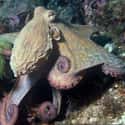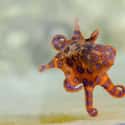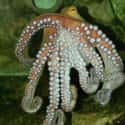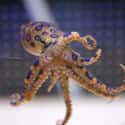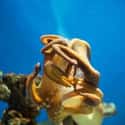-
(#1) Octopuses May Change Colors When They Dream
Scientists aren't certain whether octopuses dream when they sleep (and, even if they do, whether their dream state is anything like a human's), but Heidi the octopus made a strong case for her species when she was recorded sleeping in an episode of the PBS documentary series Nature.
In the film, the unconscious Heidi is seen twitching her tentacles, flexing her mantle, and shifting through a cascade of vibrant colors and patterns. Over the footage, marine biologist Dr. David Scheel is heard theorizing that Heidi may be dreaming about catching and eating a crab. "It's a very unusual behavior to see the color come and go on her mantle like that," he says. "You don't usually see that when an animal's sleeping."
Humans are still far away from understanding the cephalopod mind, so whether Heidi is truly dreaming or not remains speculation. Scheel has noted that the explanation for her colorful display may be much simpler: her color-changing cells could be activated by her nocturnal muscle twitches.
Neuroethologist Daniel Margoliash has suggested that animals with complicated nervous systems may need to dream to regulate their experiences and memories. In the Heidi video, Margoliash says it appears that Heidi's eyes move as if she's in a R.E.M.-like state. "Who knows!" he says. "But you can’t ignore it... You have to study it."
-
(#2) Some Female Octopuses Have Deep-Sea Nurseries
In October 2018, scientists discovered a nursery of octopuses off the coast of Monterey, CA. Researchers found thousands of Muusoctopus robustus two miles beneath the surface of the Pacific Ocean, nestling in the rocks. The females' bodies were inverted - or inside-out - which is common for females who are protecting their offspring. Some of the inverted females even had embryos still attached to their tentacles.
"We went down the eastern flank of this small hill, and that's when - boom - we just started seeing pockets of dozens here, dozens there, dozens everywhere," said Chad King, a chief scientist on the Exploration Vessel Nautilus.
Scientists also noted that the water in the area "shimmered, kind of like an oasis or heat wave off the pavement."
This discovery suggests that octopuses brood - or take care of their young - in areas that have warm water, which may help their offspring survive.
-
(#3) Octopuses Have Three Hearts
Two of an octopus's hearts move blood though the body, beyond the gills, while the third keeps circulation flowing for its organs. That third heart, called the systemic heart, stops beating when an octopus swims. This is suspected to be part of the reason why octopuses prefer to crawl.
Source: Smithsonian -
(#4) Octopuses Have Blue Blood
Octopuses have evolved a copper-based blood (rather than iron-based blood, like humans have) that allows them to survive in the deep ocean. This type of blood is blue due to a protein called hemocyanin, and it is efficient at transporting oxygen throughout the octopus's body in low temperatures.
Source: Smithsonian -
(#5) Octopuses Are Camouflage Experts
Octopuses are able to change the color of their entire body in three-tenths of a second. All cephalopods have skin that has three layers. The top outermost layer contains cells called chromatophores, which detect signals from underlying nerves and muscles and change color accordingly. Chromatophores contain red, orange, yellow, brown, and black pigments surrounded by muscles. The middle layer contains mirror-like cells called iridophores that instantaneously reflect the brightness of the animal's environment.
This is not thought to be conscious; in fact, cephalopods are believed to be colorblind! The bottom layer of skin contains white cells that provide contrast to the colors and patterns of the outer layers.
Source: Live Science
-
(#6) Octopus's Arms Even React When Severed
In some experiments, arms severed from an octopus's body jerked away when researches pinched them. This is because two-thirds of an octopus's neurons reside in its arms rather than in its brain.
Source: Smithsonian -
(#7) Male Octopuses Use Their Arms for Reproduction
The third right arm of a male octopus is special because it is his reproductive organ. In some species, this arm is visibly different from the others as it has fewer suckers. The modified arm, called the hectocotylus, holds rows of sperm called spermatophores. When mating, some species of male octopus insert the arm into a female's oviduct, while others just remove the arm and give it to her.
The female stores the arm in her mantle until she lays eggs, and then she spreads the spermatophores over the eggs herself.
Source: Mental Floss
-
(#8) Octopuses Die After Mating
After mating, male octopuses wander off and die within a few months. Meanwhile, females retreat to lairs where they lay their eggs and guard them until they hatch. They lose strength as they fend off predators and stop eating, and then slowly go through cellular suicide until they die.
Source: Smithsonian -
(#9) Octopuses Love Being Alone
Usually, octopuses only get together for mating season. They prefer to be alone. In fact, because they are feisty and competitive, octopuses in captivity are generally kept in separate tanks. In public aquariums, young octopuses are often raised behind glass dividers of other animals on display.
Source: Facts Legend -
(#10) Octopus Arms Have Minds of Their Own
Two thirds of an octopus's neurons are spread out among its arms. This allows each arm to work on separate tasks while others - and other body parts - are doing something else. Each arm is thought to have nociceptors that cue it to withdraw from stimulus that could be dangerous, even while exploring the unknown.
Source: Smithsonian -
(#11) Octopuses Construct Gardens
Some octopuses have been seen collecting shells and other objects to create gardens around their liars. They also carry shells for protection.
Source: OneKind -
(#12) There Are Over 300 Species of Octopuses
Today there are 300 different species of octopuses. The smallest is the Atlantic pygmy, whose arms are less than 4 inches long, and the largest is the seven-arm octopus, which has been recorded at 11 ft. long and weighing up to 165 lbs.
Source: Facts Legend -
(#13) Octopuses Can Regrow Their Arms
Octopuses have the ability to regrow severed arms. Research suggests this is due to an influx of the acetylcholinesterase protein, which is produced during the regrowth process.
Source: Scientific American -
(#14) Octopuses Can Smell with Their Arms
Octopus arms are riddled with suckers that do more than just help them move. These cups also assist with their ability to smell.
Source: Distractify -
(#15) Octopuses Have Hidden Beaks
Each octopus has a beak completely hidden inside its head. The beak is made of keratin, the same stuff that makes up human hair and fingernails. An octopus can not show its beak, but uses it to deliver venom to its prey and to crush crabs and mollusks.
Source: Distractify -
(#16) Octopuses See the Same Thing Regardless of Body Position
Octopuses are able to keep their eyes in the same orientation regardless of their body position. Sensory receptors called statocysts keep the pupils balanced as the octopus moves, which allows it to see the same whether it upside down or right-side up. It also has horizontal pupils, while humans have vertical ones.
Source: Mental Floss -
(#17) Octopuses Ink Is More Than a Distraction
Octopuses use their ink to distract prey and keep them from getting away. However, the ink also contains an enzyme called tyrosinase, which causes blinding irritation when it gets into another animal's eyes. It also messes with their prey's sense of smell and taste.
Source: Smithsonian -
(#18) All Octopuses Are Venomous
Every octopus species has venom proteins in its body, which it delivers to prey through biting with its beak. However, only the blue-ring octopus is truly dangerous to adult humans. In fact, it's one of the most venomous animals in the world, with enough lethal tetrodotoxin in its body to suffocate 10 adult men.
Source: National Geographic -
(#19) Octopuses Are Great Problem Solvers
Many octopuses have been seen unscrewing lids (even childproof ones!) and removing plugs in order to get to their prey. Researchers that keep octopuses in captivity provide the animals with complicated "toys" that test and develop the animals' cognitive abilities. After all, these clever creatures are known to become easily bored - and a bored octopus can be both a menace to its handlers and a danger to itself if it fixates on escaping its tank.
Source: Facts Legend -
(#20) Octopuses Are Very Fast Swimmers
Octopuses are able to jet themselves forward by expelling water through their mantles. This makes them incredibly fast swimmers.
Source: OneKind -
(#21) Octopuses Were Some of the First Invertebrates to Be Seen Using Tools
Octopuses were the first invertebrates to be seen using tools. For example, some select and carry coconut shells to use as camouflage and shelter that protects them from predators.
Source: OneKind
New Random Displays Display All By Ranking
About This Tool
Octopuses are extremely complex, mysterious, and talented creatures with many hidden talents. These invertebrate but colorful marine animals have existed for thousands of years, making the ocean world interesting. They are masters of defense and able to disguise their entire body in seconds, due to the lack of a skeleton, they are very agile and can even grow their lost arms.
For centuries, their unique defense mechanism has fascinated biologists. Various octopuses are widely distributed in tropical and temperate waters around the world. The random tool introduced 21 fun facts about octopuses that most people may not know.
Our data comes from Ranker, If you want to participate in the ranking of items displayed on this page, please click here.





















